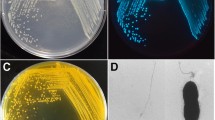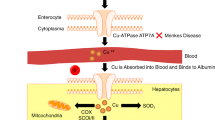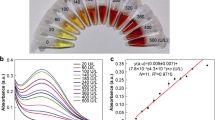Abstract
The serum concentrations of copper, zinc, iron, and cobalt and copper/zinc ratio were investigated in horses infected with equine herpesvirus-1 (EHV-1). Nine horses were naturally infected with the virus and nine healthy horses served as controls. The concentrations of copper, zinc, iron, and cobalt were determined spectrophotometrically in the blood serum of all horses. The results were (expressed in micrograms per deciliters) copper 2.80 ± 0.34 vs 1.12 ± 0.44, zinc 3.05 ± 0.18 vs 0.83 ± 0.06, iron 2.76 ± 0.17 vs 3.71 ± 0.69, cobalt 0.19 ± 0.37 vs 0.22 ± 0.45, and copper/zinc ratio 0.72 ± 0.38 vs 1.41 ± 0.36 for control vs infected group, respectively. In conclusion, copper and zinc concentrations of the infected group were lower than the control group (p < 0.001), whereas iron concentration and the copper/zinc ratio of the infected group were higher than the control group (p < 0.05 and p < 0.001). The cobalt concentration was not found to be statistically different between two groups. It might be emphasized that copper/zinc ratio was significantly affected by the EHV-1 infection, so it could be taken into consideration during the course of infection.
Similar content being viewed by others
References
Failla ML (2003) Trace elements and host defense: recent advances and continuing challenges. J Nutr 133:1443–1447
Chaturvedi UC, Shrivastava R, Upreti RK (2004) Viral infections and trace elements: a complex interaction. Curr Sci 87:1536–1554
Erickson KL, Medina EA, Hubbard NE (2000) Micronutrients and innate immunity. J Infect Dis 182:5–10
Suttle NF, Jones DG (1989) Recent developments in trace element metabolism and function: trace elements, disease resistance and immune responsiveness in ruminants. J Nutr 119:1055–1061
Shankarand AH, Prasad AS (1998) Zinc and immune function: the biological basis of altered resistance to infection. Am J Clin Nutr 68:447–463
Stokes A, Corteyn AH, Muray K (1991) Clinical signs and humoral immune response in horses following equine herpes virus type-1 infection and their susceptibility to EHV-4 challenge. Vet Sci 51:141–148
Bancroff JD, Cook HJ (1984) Mammal of histological techniques. Livingstone, New York
Greenberg WE, Trusell RR, Clescer LS (1996) Standard methods for the examination of water and wastewater, 60th edn. American Public Health Association, Washington DC
Kydd JH, Townsend HG, Hannant D (2006) The equine immune response to equine herpesvirus-1: the virus and its vaccines. Vet Immunol Immunopathol 111:15–30
Taouji S, Collobert C, Gicquel B, Sailleau C, Brisseau N, Moussu C, Breuil FM, Pronost S, Borchers K, Zientara S (2002) Detection and isolation of equine herpesvirus 1 and 4 from horses in Normandy: an autopsy study of tissue distribution in relation to vaccination status. J Vet Med B 49:394–399
Knipe DM (1990) Virus–host–cell interactions. In: Virology. Raven Press, New York
Underwood EJ (1977) Trace elements in human and animal nutrition. Academic Press, New York
Schwartz LH, Urban T, Herzberg S (1994) Antioxidant minerals and vitamins. Role in cancer prevention. Press Med 23:1826–1830
Dede S, Değer Y, Mert N, Kahraman T, Alkan M, Keleş I (2003) Studies on the effects of x-ray on erythrocyte zinc and copper concentrations in rabbits after treatment with antioxidants. Biol Trace Elem Res 92:55–60
Hatano R, Ebara M, Fukuda H, Yoshikawa M, Sugiura N, Kondo F, Yukawa M, Saisho H (2000) Accumulation of copper in liver and hepatic injury in chronic hepatitis C. J Gastroenterol Hepatol 15:786–791
Pramoolsinsap C, Promvanit N, Kurathongs S (1996) Serum trace metal levels in patients with acute hepatitis B. Southeast Asian J Trop Med Public Health 27:476–480
Barlow RM, Suttle NF, Derbyshire MB, Gardiner AC, Rennie JC (1976) Copper metabolism in experiment Border disease. Vet Rec 98:86–88
Arthington JD, Corah LR, Blecha F (1996) The effect of molybdenum-induced copper deficiency on acute phase protein concentrations, SOD activity, leucocyte numbers, and lymphocyte proliferation in beef heifers inoculated with bovine herpes-virus. J Anim Sci 74:211–217
Mocchegiani E, Muzzioli M (2000) Therapeutic application of zinc in human immunodeficiency virus against opportunistic infections. J Nutr 130:1424–1431
Baum MK, Shor-Posner G, Campa A (2000) Zinc status in human immunodeficiency virus infection. J Nutr 130:1421–1423
Fernandez-Pol JA, Hamilton PD, Klos DJ (2001) Essential viral and cellular and iron containing metalloproteins as targets for novel antiviral and anticancer agents: implications for prevention and therapy of viral diseases and cancer. Anticancer Res 21:931–957
Fota-Markowska H, Przybyla A, Borowicz I, Modrzewska R (2002) Serum zinc (Zn) level dynamics in blood serum of patients with acute viral hepatitis B and early recovery period. Ann Univ Mariae Curie-Sklodowska Sect D Med 57:201–209
Nagamine T, Takagi H, Hashimoto Y, Takayama H, Shimoda R, Nomura N, Suzuki K, Mori M, Nakajima K (1997) The possible role of zinc and metallothionein in the liver in the therapeutic effect of IFN-alpha to hepatitis C patients. Biol Trace Elem Res 58:65–76
Koch J, Neal EA, Schlott MJ, Garcier-Shelton YL, Chan MF, Weaver KE, Cello JP (1996) Zinc levels and infections in hospitalized patients with AIDS. J Nutr 12:515–518
Wellinghausen N, Kean WV, Jochle W, Kern P (2000) Zinc serum level in human immunodeficiency virus-infected patients in relation to immunological status. Biol Trace Elem Res 73:139–149
Kalkan A, Bulut V, Avci S, Celik I, Bingol NK (2002) Trace elements in viral hepatitis. J Trace Elem Med Biol 16:227–230
Orr CL, Hutcheson DP, Grainger RB, Cummins JM, Mock RE (1990) Serum copper, zinc, calcium and phosphorus concentrations of calves stressed by bovine respiratory disease and infectious bovine rhinotracheitis. J Anim Sci 68(9):2893–2900
Funseth E, Lindh U, Friman G, Ilback NG (2000) Relation between trace element levels in plasma and myocardium during coxsackievirus B3 myocarditis in the mouse. BioMetals 13:361–367
Greig A, Macleod NS, Allison CJ (1977) Tick borne fever in association with nurusol disease and cobalt deficiency in calves. Vet Rec 100:562–564
Weinberg ED (1990) Cellular iron metabolism in health and disease. Drug Metab Rev 22:531–579
Lin CC, Huang JF, Tsai LY, Huang YL (2006) Selenium, iron, copper, and zinc levels and copper-to-zinc ratios in serum of patients at different stages of viral hepatic diseases. Biol Trace Elem Res 109:15–24
Fota-Markowska H, Rolla-Szczepanska R, Modrzewska R, Lis-Tonder J, Borowicz I (2003) Copper/zinc ratio in measles patients. Ann Univ Mariae Curie-Sklodowska 58(1):291–296
Ciftci TU, Ciftci B, Yis O, Guney Y, Bilgihan A, Ogretensoy M (2003) Changes in serum selenium, copper, zinc levels and Cu/Zn ratio in patients with pulmonary tuberculosis during therapy. Biol Trace Elem Res 95:65–71
Author information
Authors and Affiliations
Corresponding author
Additional information
An erratum to this article can be found at http://dx.doi.org/10.1007/s12011-007-8032-4
Rights and permissions
About this article
Cite this article
Yörük, İ., Deger, Y., Mert, H. et al. Serum Concentration of Copper, Zinc, Iron, and Cobalt and the Copper/Zinc Ratio in Horses with Equine Herpesvirus-1. Biol Trace Elem Res 118, 38–42 (2007). https://doi.org/10.1007/s12011-007-0023-y
Received:
Revised:
Accepted:
Published:
Issue Date:
DOI: https://doi.org/10.1007/s12011-007-0023-y




